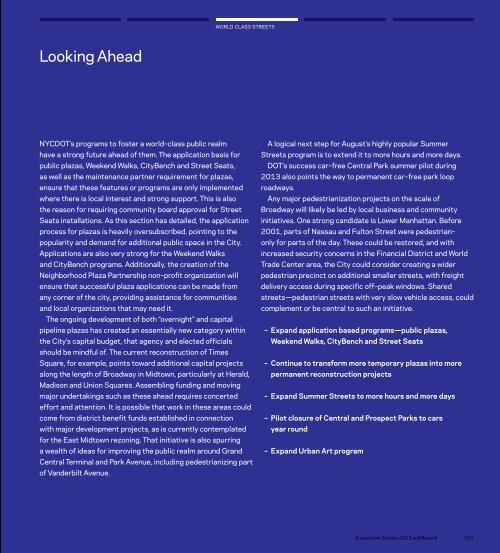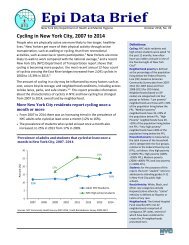2013-dot-sustainable-streets-lowres
2013-dot-sustainable-streets-lowres
2013-dot-sustainable-streets-lowres
Create successful ePaper yourself
Turn your PDF publications into a flip-book with our unique Google optimized e-Paper software.
WORLD CLASS STREETSLooking AheadNYCDOT’s programs to foster a world–class public realmhave a strong future ahead of them. The application basis forpublic plazas, Weekend Walks, CityBench and Street Seats,as well as the maintenance partner requirement for plazas,ensure that these features or programs are only implementedwhere there is local interest and strong support. This is alsothe reason for requiring community board approval for StreetSeats installations. As this section has detailed, the applicationprocess for plazas is heavily oversubscribed, pointing to thepopularity and demand for additional public space in the City.Applications are also very strong for the Weekend Walksand CityBench programs. Additionally, the creation of theNeighborhood Plaza Partnership non–profit organization willensure that successful plaza applications can be made fromany corner of the city, providing assistance for communitiesand local organizations that may need it.The ongoing development of both “overnight” and capitalpipeline plazas has created an essentially new category withinthe City’s capital budget, that agency and elected officialsshould be mindful of. The current reconstruction of TimesSquare, for example, points toward additional capital projectsalong the length of Broadway in Midtown, particularly at Herald,Madison and Union Squares. Assembling funding and movingmajor undertakings such as these ahead requires concertedeffort and attention. It is possible that work in these areas couldcome from district benefit funds established in connectionwith major development projects, as is currently contemplatedfor the East Midtown rezoning. That initiative is also spurringa wealth of ideas for improving the public realm around GrandCentral Terminal and Park Avenue, including pedestrianizing partof Vanderbilt Avenue.A logical next step for August’s highly popular SummerStreets program is to extend it to more hours and more days.DOT’s success car–free Central Park summer pilot during<strong>2013</strong> also points the way to permanent car–free park looproadways.Any major pedestrianization projects on the scale ofBroadway will likely be led by local business and communityinitiatives. One strong candidate is Lower Manhattan. Before2001, parts of Nassau and Fulton Street were pedestrian–only for parts of the day. These could be restored, and withincreased security concerns in the Financial District and WorldTrade Center area, the City could consider creating a widerpedestrian precinct on additional smaller <strong>streets</strong>, with freightdelivery access during specific off–peak windows. Shared<strong>streets</strong>—pedestrian <strong>streets</strong> with very slow vehicle access, couldcomplement or be central to such an initiative.– Expand application based programs—public plazas,Weekend Walks, CityBench and Street Seats– Continue to transform more temporary plazas into morepermanent reconstruction projects– Expand Summer Streets to more hours and more days– Pilot closure of Central and Prospect Parks to carsyear round– Expand Urban Art programSustainable Streets: <strong>2013</strong> Sustainable and Beyond Streets: <strong>2013</strong> and Beyond151



